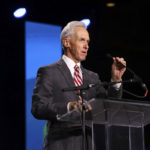MCALLEN—Projected trends for population growth and demographic change have important—perhaps jarring—implications for Texas Baptist churches and their goal of reaching the lost with the gospel, workshop participants at Texas Baptists’ Family Gathering learned.
Tom Howe, director of church starting and replanting at the Baptist General Convention of Texas, led a workshop focused on the future of Texas.
Using the illustrations of four types of snow—a snow shower, a blizzard, winter and an ice age— Howe suggested Texas is in the early stages of winter or an ice age. Either, he said, requires a much different level of preparation than a snow shower or blizzard.
“Winters are interruptions—for example, the COVID pandemic,” Howe said. “If it’s an ice age, we have to change everything.”
“The world is changing all around us,” he added.
Texas surpassed 30 million in population in fall 2022. By 2030, the state is expected to add 5.2 million more people—more than Arkansas or Louisiana’s total population. But by 2050, projections have the state’s population nearly doubling, which would mean Texas would surpass California as the most populous state.
The Dallas-Fort Worth area is expected to add 9 million to 10 million by 2050, Howe said, while Houston will add 8.5 million to 9 million; the Austin-San Antonio area will likely add 5 million to 7.6 million. Howe said several public officials have suggested his estimates are too low.
Dramatic demographic changes
But it’s more than simply numbers, Howe said. Texas’ demographics continue a rapid shift. In 1970, Texas was 86.8 percent white and 12 percent Black. By 2020, the state was 50.1 percent white, 12 percent Black, 5 percent Asian, 13 percent other and 17.6 percent “two or more races.”
“If your church is going to be all white, all Black, all Hispanic, you’re already missing 20 percent of the population,” Howe said.
Sign up for our weekly edition and get all our headlines in your inbox on Thursdays
Hispanics are now the largest people group in Texas, at 40.2 percent, compared to 39.3 percent non-Hispanic white, he noted.
Likewise, religious identification continues to decline. Fewer than 50 percent of Texans have any affiliation with religion, Howe said.
“Add another 5 million and we’ll have a lost culture of 20 million in Texas by 2030,” he said. “We’ve got a mission field here in Texas now. Not coming. It came.”
Discouraging congregational trends
Against that backdrop, Texas mirrors the national trend in churches. More churches are closing the doors each year than are started. If that trend continues, he noted, it means by 2050, the population of Texas will double and the number of churches will be cut in half.
The Baptist General Convention of Texas and the Southern Baptists of Texas Convention combined have about 7,000 churches, he said, but if the numbers hold and trends continue, they combined would have about 3,500 by 2050.
“What happens when the population doubles and the number of churches is cut in half? It’s not good, whatever it is,” Howe said. “We’ll have less people trying to reach more people that desperately need the gospel. There’s a great need for healthy churches.”
If every Texas Baptists church grew by 200 members, Howe said, and Texas Baptists started 500 churches that each grew to at least 200 people, the growth would equal about 1.1 million, “and we’d be ecstatic,” he said. “But if Texas grows by 20 million, and we’ve added a million, we’ve missed 95 percent of the lost people in Texas.”
Additionally, Howe outlined the habits and expectations of millennials and Gen Z. Churches must be willing and ready to adapt to all of the changes in populations, demographics and habits, he said.
“The task is large, but we’ve got a big God,” Howe said.
The solution requires churches to change
The solution looks different with each church and each community, Howe said, but it requires change from every church. As Mark Clifton, senior director of replanting for the North American Mission Board, put it: “The community does not exist for your church; your church exists for the community.”
Howe said churches’ leaders must “become adaptive leaders,” alluding to Ted Bolsinger’s book, Canoeing the Mountains. Referencing the journey of Lewis and Clark in the early 19th Century, he noted their understanding of their task changed dramatically when they first sighted the Rocky Mountains.
“As we look at this new Texas that’s coming, what we think we know about church work is what they thought they knew about America until they got to the Rocky Mountains,” Howe said.
Howe suggested pastors and other church leaders must get to know their community, compiling a community profile. Then produce a profile of their church and study the difference. Next, he said, they must build a “strategic bridge” from church to community.
“Start with what you know,” he said. “You know your community. Start paying attention to the movements. What new population is moving in or out? What plants are moving in or shutting down? Where are they building new subdivisions? You’ve got to be considering these things. You’ve got to learn your community and find the leverage points you have.”
Rather than feeling overwhelmed, Howe said Texas Baptists should see the potential.
“We have an incredible opportunity, for the first time ever, to reach a Texas that has never existed,” he said. “Every generation has that. Let’s reach it. Let’s go make a difference in our communities. The world is coming to Texas. We don’t even have to do missions without leaving Texas. We can stay here. Jesus is bringing them to us.
“We can go outside, too. We can do that. … Let’s be part of changing Texas.”















We seek to connect God’s story and God’s people around the world. To learn more about God’s story, click here.
Send comments and feedback to Eric Black, our editor. For comments to be published, please specify “letter to the editor.” Maximum length for publication is 300 words.